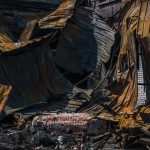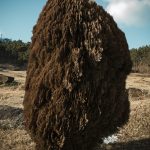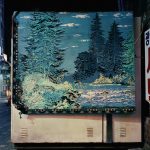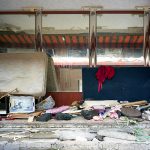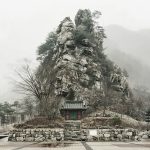The texture of time and space in his works feels different from the one that you may have encountered when you appreciate other photos of landscapes or events. It seems that multi-perspectives are condensed in each cut like the ones in traditional Far East Asian paintings. This effect leads the viewers to step into his works. You will find yourself strolling in the overwhelming situations in his works and also going through the time and space of them, pondering and responding to them.
When you are ‘strolling in the works of art’, pondering the meaning of them, it means that you are revealing your experiences in spite of yourself and positioning yourself in between your individual memories and collective memory. Furthermore, when you are going through the works, with a critical view to the time and space in them, it can also mean you are trying to find what is the problem in the real present world. That is, the spots Mr. An shot are the places where his memories remain and social systems are working at the same time. The places consist of miners’ town, a red light district, Chongno-streets, the places his father had taken pictures of and a factory that had burned down.

Mr. An’s works show the epitomized stream of past, present and future all at once that is projected on the subjects. It is said that he had taken pictures of the soldiers when he was in the army. Working on the soldiers in drills, night views in the camp, barbed-wires and etc, he made them seem to appear in timeless space, extremely compacted, by placing a invisible thick screen between his works and viewers, so to speak. So it seems that in his works, present, past and future are mingled together and condensed intensely.
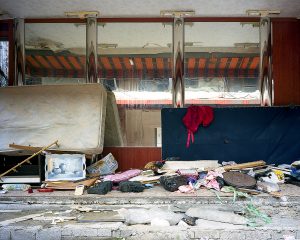
‘Red Rooms'(2011), in which what they call ‘red light district’ in Yongsan is expressed, shows useless and vacant faces of the district that was deserted and left alone by the city-redeveloping policy and its uselessness. Unaccountable red lit shapes and spaces in the works have the power that reminds us of the so many stories and miserables all at once. The sequence of past, present and future emerges through scribbles on the wall, deserted objects in the city, which implicitly comprise the stories about the people who were there. The objects in the photos, as if fossils, make us remind of the drama of the people who stayed there and the system that is not working anymore.

‘Future Land'(2013) consists of the works on the mining town, in which he makes metaphors that the mining industry is not in the progress, but the photographer hopes that ‘present’ still contains some future dream. Decades ago, mining was under the spotlight, so there were capitals rushing up, utopian dreams gathering up. But now the towns and the infrastructures became spaces that can hardly find usefulness. It was not just a difficult situation but a situation in which the remains are getting into nothingness by the sluggish flow of time. Colorful town life was gone into ruins, some light posts bending, the pillar of a building seeming morbidly cold. The photographer, however, sees not only the devastation in failure but also sees there are seeds of hope of recovering in it. So Mr. An leads the miserable conditions under the hopeful light as if they were relics that should be rediscovered.

Working on ‘Passage’, Mr. An gets to a turning point. While previous works deal with tragic spots in a society, in “Passage’, the tragic spot is of his own rather than that of others’. One day his father got a stroke and he got into a condition of having to tend him. Under this condition he had to walk through streets in Chogno (to go to the hospita) and began to experience nights and days, evenings and dawns of the street. Walking through the same area by routine he began to scrutinize the things such as neon signs, motel signs, vending machines, a pavilion fallen, streets under construction, the back side of a bronze stature that was covered by a screen etc. and these various scenes in the oldest and lively part of Seoul make ways into his brain in the new light. The streets of Chongno, which can be a place of only once in a lifetime to someone and which can be a routine place to another, became a part of a passage of life to him.

In this course, he looks back on his father and himself. His father was a businessman and had a career of an amateur photographer. Mr. An himself did not major photography at first and when he became a professional photographer he may have rejected to be under the clout of his father. Working on ‘Passage’, he not only found the hidden sides of Chongno but found the influence of his father he had tried to deny and these factors enabled him to complete his ‘Passage’ works. And this awakening also leads to his ‘Landscape’.
In a sense, as much of photo-taking of city-scapes and redevelopment is a major part of photography, so is the landscape shooting both for pro-photographers and amateur shooters. Mr. An builds up a myth-like image by repeated observing routine and ordinary landscapes and captures essential factors of time and space in them, which can be said as historical factors. Fragments of impressions, which got abstracted from the subjects, seem to contain rather a ‘future dream’ than hopelessness shown from his past works. Flowers, which appear to be alienated from nature and scattered randomly, in an instant, become a passage that leads through from the past to future by absorbing all those unbalanced factors. This is, may be, a metaphor that his seemingly separated works would be unified into a collosal art system with his own history.
Though images taken from the nature do not seem to have relevance to the technology of capitalism and speedy changes in the society, the change of the nature is not different from the one resulted in the political human society, either. Where we mistake the nature for being eternal, An clearly tells us that it is not. In addition, in his works – ‘Army’, ‘Red Room’, ‘Future Land’ and ‘Passage’ – though accorded with the objects are photographic symbols, in the ‘Landscape’, there lies vagueness in which myth-like subjects contain various symbols and meanings like a montage.

‘Daylight’ series shows the naked entity of evolution of the nature through irony. There lie a possibility of progression and that of extinction at the same time, which is shown from the charcoal dark tree trunks. Something that can be dead also has a possibility to be alive again so we can say that it is the process of decay and death that can make life goes on. History can either make a progression or a recession, and An tries to let himself be at the middle in the course of the current and to reveal the hidden meanings by highlighting the reality.
The characteristic that he embraces the past and future at the point of here and now has a relevance to the tempo of his shooting. We think that in general the shooting speed is decided by a shooter at his own will, so it can be said that a shooter holds an absolute authority. In his case, he spends long time researching and selecting the spots to be taken but very short time deciding to shoot. The less time it takes, the more powerful and condensed the photographic effects are.
An calls the intermediate moment as ‘normal’. It is, no doubt, ‘present’ in the time sequence, but it can be called ‘normal’ in the social context, he thinks. It, however, is the moment of birth of a drama when a photographer either overcomes the ‘normal’ or breaks down the ‘normal’.
An has been trying to reveal the hidden sides, which can be made when the balance is broken between the accustomed and the newly found, throughout ‘the utopia natural’ and ‘the utopia real’. Just as he found something novel from the things accustomed while he was commuting the same road, so we can find the something new dig into our consciousness in the routine. The finding that did not exist yesterday can be a disaster when its another side invade the mind of a watcher and it can also make a dramatic change in the life of the finder who was on the course of history. The change can occur either in the still life of the nature or in the dynamic city life all the same. I hope that An can be at the ‘normal point’, finding the change and making the change appear on his works without cease.
* Utopia natural means his work ‘Landscape’ while Utopia real does ‘Chogno’.
